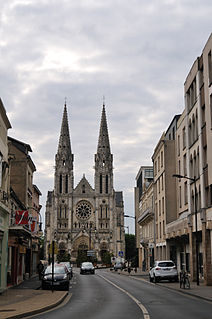
Amiens is a city and commune in northern France, located 120 km (75 mi) north of Paris and 100 km (62 mi) south-west of Lille. It is the capital of the Somme department in the region of Hauts-de-France. In 2021, the population of Amiens was 135,429. A central landmark of the city is Amiens Cathedral, the largest Gothic cathedral in France. Amiens also has one of the largest university hospitals in France, with a capacity of 1,200 beds. The author Jules Verne lived in Amiens from 1871 until his death in 1905, and served on the city council for 15 years. Incumbent French president Emmanuel Macron was born in Amiens.

Saint-Omer is a commune and sub-prefecture of the Pas-de-Calais department in France.

Châteauroux is the capital city of the French department of Indre, central France and the second-largest town in the province of Berry, after Bourges. Its residents are called Castelroussins.

Berck, sometimes referred to as Berck-sur-Mer, is a commune in the northern French department of Pas-de-Calais. It lies within the Marquenterre regional park, an ornithological nature reserve.

Vézelay is a commune in the department of Yonne in the north-central French region of Bourgogne-Franche-Comté. It is a defensible hill town famous for Vézelay Abbey. The town and its 11th-century Romanesque Basilica of St Magdalene are designated UNESCO World Heritage Sites.

Vauvert is a commune in the far south of the Gard department in southern France. It was known as Posquières in the Middle Ages. The commune comprises the town of Vauvert and the villages of Gallician and Montcalm. Over a third of the population work in industry, which is largely the food industry, especially wine production. The original settlement was called Posquières and was first mentioned in a document of 810. Since then the town has increased in importance and has had a rich history. At its heyday in the mid-nineteenth century it had a population of 6,000 but this decreased by a third after disease struck the grape crop, the mainstay of the economy of the area. Today, the population has grown again to over 11,000.

Conchil-le-Temple is a commune in the Pas-de-Calais department in the Hauts-de-France region of France.

Bertangles is a commune in the Somme department in Hauts-de-France in northern France.

Erckartswiller is a commune, in the Bas-Rhin department in Grand Est in north-eastern France. It is part of the arrondissement of Saverne and the canton of Ingwiller.

Cerisy is a commune in the Somme department in Hauts-de-France in northern France.

Coullemelle is a commune in the Somme department in Hauts-de-France in northern France.

Sains-en-Amiénois is a commune in the Somme department in Hauts-de-France in northern France.

Abbeville is a commune in the Somme department and in Hauts-de-France region in northern France.

René Debrie was a French linguist.

Philéas Lebesgue was a French essayist and translator. At once a poet, novelist, essayist, translator and literary critic.

The Abbey of St. Vincent, Laon was a Benedictine monastery in Laon, Picardy, northern France. It was founded in c. 580 and initially followed the Rule of St. Columbanus, adopting the Rule of St. Benedict in 948.
Louis Eugène Ferdinand Pouy was a 19th-century French writer and bibliographer
The Compagnie d'Arc d'Amiens is an archery club founded on 14 November 1803 in Amiens and affiliated to the Fédération française de tir à l'arc and the Fédération française handisport.

Edmond Clément Marie Duthoit (1837–1889) was a French 19th-century architect, originating from Amiens. He was the eldest son of Aimé Duthoit, the nephew of Louis Duthoit, both picard designers and sculptors, and the father of Louis Duthoit.

Marcheroux Abbey is a former Premonstratensian monastery dedicated in honour of Saint Nicholas in Beaumont-les-Nonains in Les Hauts-Talican south of Beauvais, Picardy, France. The site has been registered as a monument historique since 1995.






















